ITC211 System Analysis: Cloud-Based Information System Report
VerifiedAdded on 2022/08/16
|6
|1249
|17
Report
AI Summary
This report examines the implementation of a cloud-based information system for a cake franchise, addressing the challenges of managing inventory, wastage, and store performance. It highlights the advantages of cloud-based solutions, such as abundant storage space, mobile accessibility, and automated updates. The report also acknowledges the weaknesses, including security concerns and the need for employee training. A comparison of the Unified Process (UP) and Scrum methodologies is provided, with Scrum recommended for its flexibility in the context of the franchise's operational needs. The report concludes that a cloud-based system can streamline operations, improve inventory management, track performance, and facilitate employee engagement, while also addressing security measures to prevent unauthorized access. The report provides a valuable analysis of how cloud-based systems can improve business efficiency and decision-making for the cake franchise.
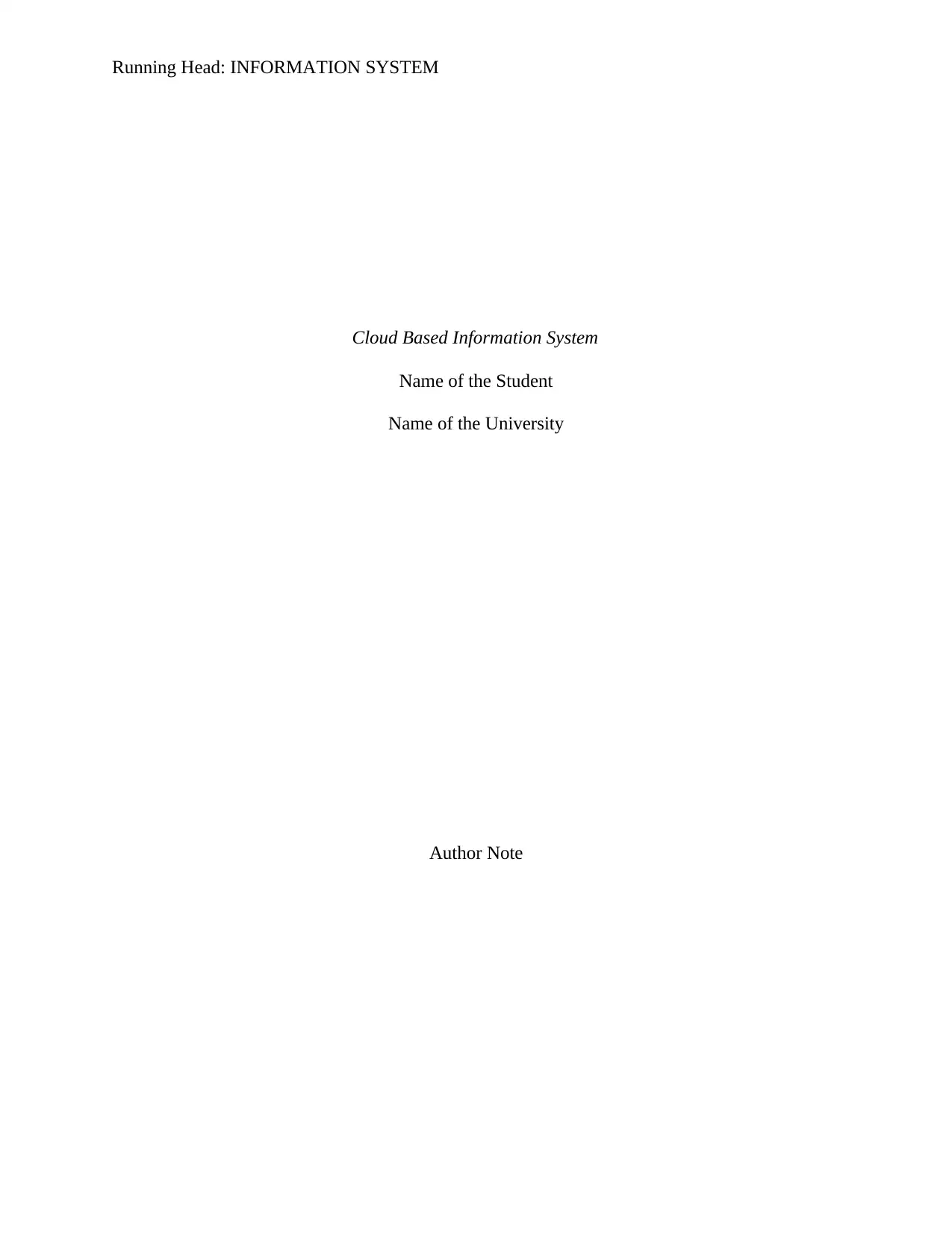
Running Head: INFORMATION SYSTEM
Cloud Based Information System
Name of the Student
Name of the University
Author Note
Cloud Based Information System
Name of the Student
Name of the University
Author Note
Paraphrase This Document
Need a fresh take? Get an instant paraphrase of this document with our AI Paraphraser
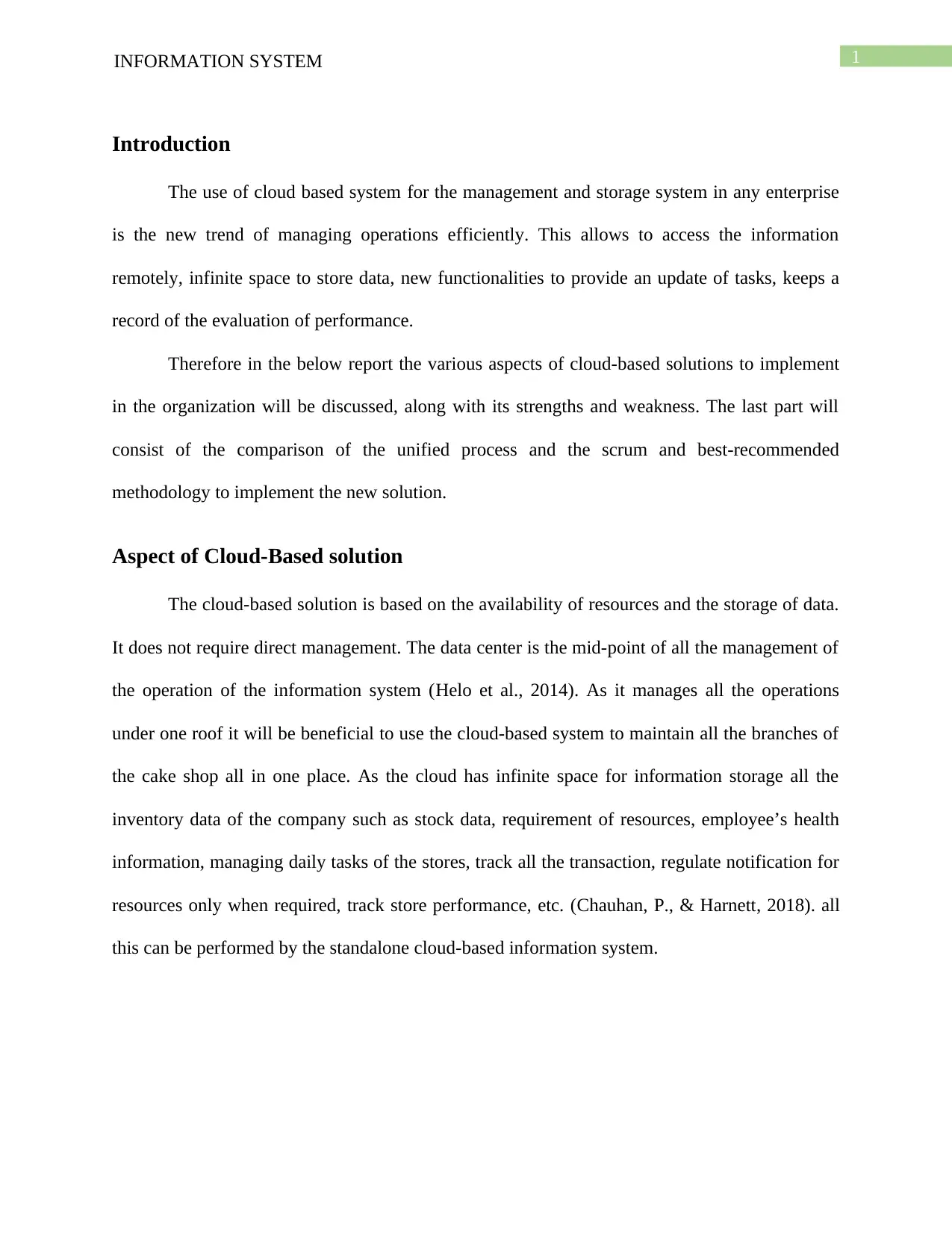
1INFORMATION SYSTEM
Introduction
The use of cloud based system for the management and storage system in any enterprise
is the new trend of managing operations efficiently. This allows to access the information
remotely, infinite space to store data, new functionalities to provide an update of tasks, keeps a
record of the evaluation of performance.
Therefore in the below report the various aspects of cloud-based solutions to implement
in the organization will be discussed, along with its strengths and weakness. The last part will
consist of the comparison of the unified process and the scrum and best-recommended
methodology to implement the new solution.
Aspect of Cloud-Based solution
The cloud-based solution is based on the availability of resources and the storage of data.
It does not require direct management. The data center is the mid-point of all the management of
the operation of the information system (Helo et al., 2014). As it manages all the operations
under one roof it will be beneficial to use the cloud-based system to maintain all the branches of
the cake shop all in one place. As the cloud has infinite space for information storage all the
inventory data of the company such as stock data, requirement of resources, employee’s health
information, managing daily tasks of the stores, track all the transaction, regulate notification for
resources only when required, track store performance, etc. (Chauhan, P., & Harnett, 2018). all
this can be performed by the standalone cloud-based information system.
Introduction
The use of cloud based system for the management and storage system in any enterprise
is the new trend of managing operations efficiently. This allows to access the information
remotely, infinite space to store data, new functionalities to provide an update of tasks, keeps a
record of the evaluation of performance.
Therefore in the below report the various aspects of cloud-based solutions to implement
in the organization will be discussed, along with its strengths and weakness. The last part will
consist of the comparison of the unified process and the scrum and best-recommended
methodology to implement the new solution.
Aspect of Cloud-Based solution
The cloud-based solution is based on the availability of resources and the storage of data.
It does not require direct management. The data center is the mid-point of all the management of
the operation of the information system (Helo et al., 2014). As it manages all the operations
under one roof it will be beneficial to use the cloud-based system to maintain all the branches of
the cake shop all in one place. As the cloud has infinite space for information storage all the
inventory data of the company such as stock data, requirement of resources, employee’s health
information, managing daily tasks of the stores, track all the transaction, regulate notification for
resources only when required, track store performance, etc. (Chauhan, P., & Harnett, 2018). all
this can be performed by the standalone cloud-based information system.
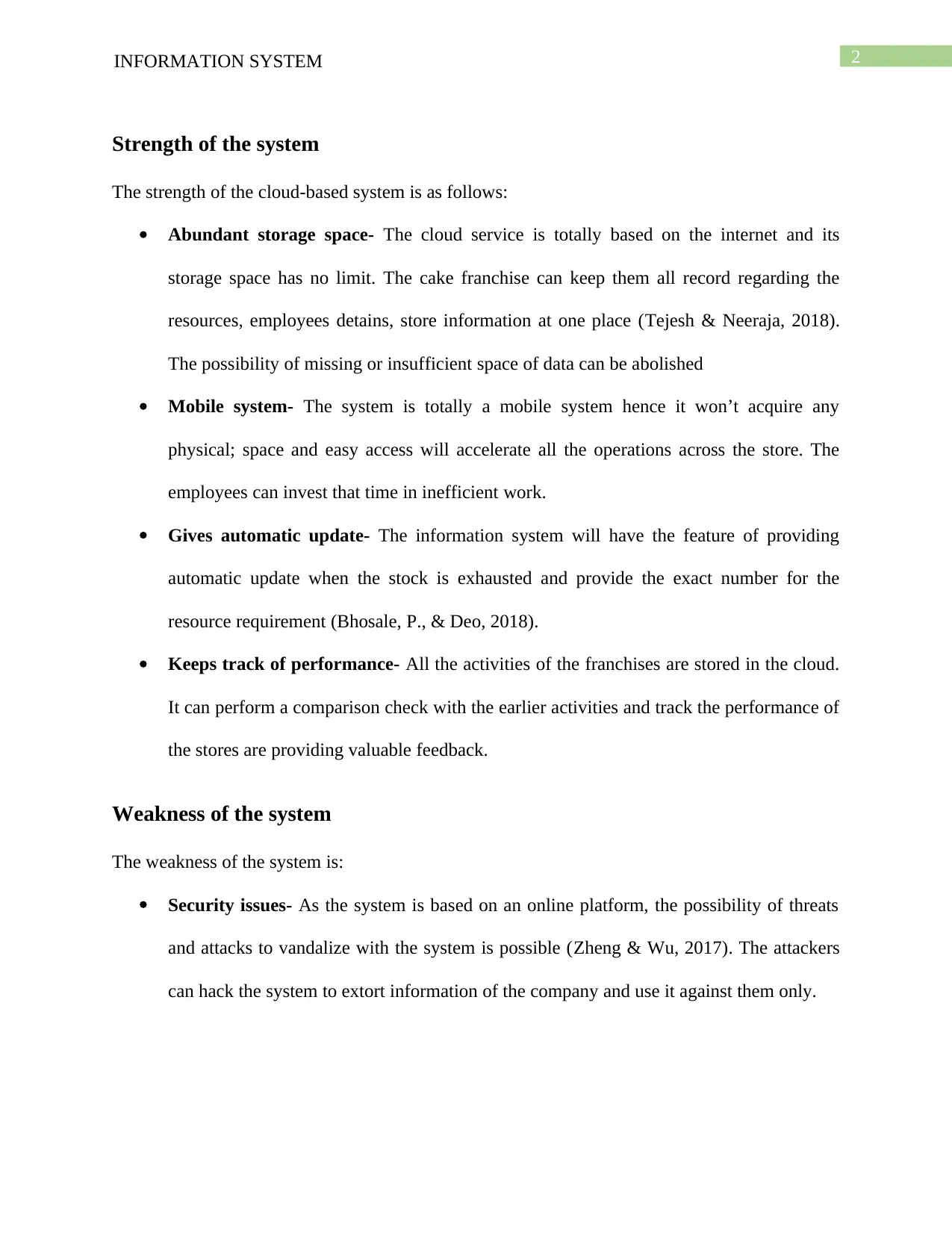
2INFORMATION SYSTEM
Strength of the system
The strength of the cloud-based system is as follows:
Abundant storage space- The cloud service is totally based on the internet and its
storage space has no limit. The cake franchise can keep them all record regarding the
resources, employees detains, store information at one place (Tejesh & Neeraja, 2018).
The possibility of missing or insufficient space of data can be abolished
Mobile system- The system is totally a mobile system hence it won’t acquire any
physical; space and easy access will accelerate all the operations across the store. The
employees can invest that time in inefficient work.
Gives automatic update- The information system will have the feature of providing
automatic update when the stock is exhausted and provide the exact number for the
resource requirement (Bhosale, P., & Deo, 2018).
Keeps track of performance- All the activities of the franchises are stored in the cloud.
It can perform a comparison check with the earlier activities and track the performance of
the stores are providing valuable feedback.
Weakness of the system
The weakness of the system is:
Security issues- As the system is based on an online platform, the possibility of threats
and attacks to vandalize with the system is possible (Zheng & Wu, 2017). The attackers
can hack the system to extort information of the company and use it against them only.
Strength of the system
The strength of the cloud-based system is as follows:
Abundant storage space- The cloud service is totally based on the internet and its
storage space has no limit. The cake franchise can keep them all record regarding the
resources, employees detains, store information at one place (Tejesh & Neeraja, 2018).
The possibility of missing or insufficient space of data can be abolished
Mobile system- The system is totally a mobile system hence it won’t acquire any
physical; space and easy access will accelerate all the operations across the store. The
employees can invest that time in inefficient work.
Gives automatic update- The information system will have the feature of providing
automatic update when the stock is exhausted and provide the exact number for the
resource requirement (Bhosale, P., & Deo, 2018).
Keeps track of performance- All the activities of the franchises are stored in the cloud.
It can perform a comparison check with the earlier activities and track the performance of
the stores are providing valuable feedback.
Weakness of the system
The weakness of the system is:
Security issues- As the system is based on an online platform, the possibility of threats
and attacks to vandalize with the system is possible (Zheng & Wu, 2017). The attackers
can hack the system to extort information of the company and use it against them only.
⊘ This is a preview!⊘
Do you want full access?
Subscribe today to unlock all pages.

Trusted by 1+ million students worldwide
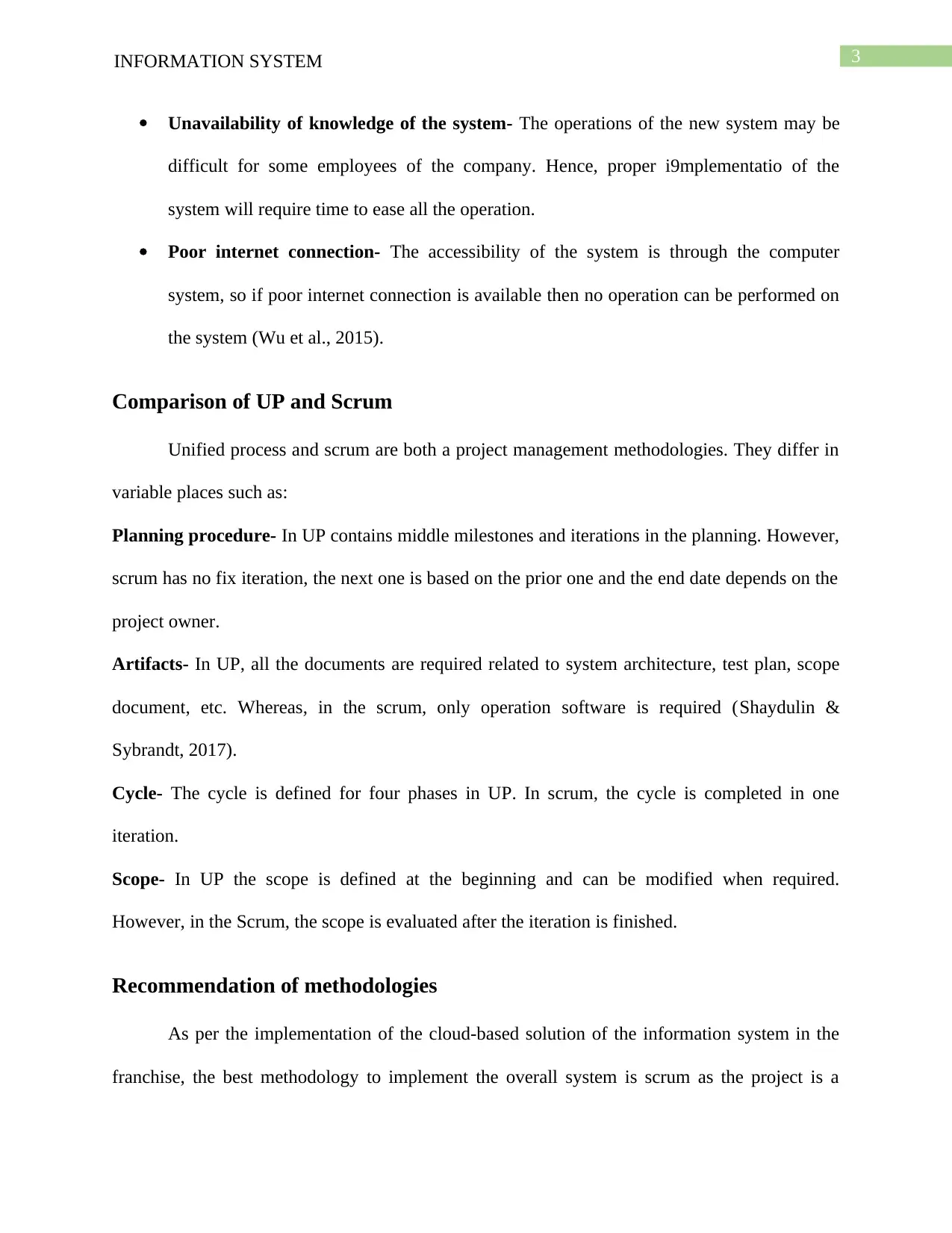
3INFORMATION SYSTEM
Unavailability of knowledge of the system- The operations of the new system may be
difficult for some employees of the company. Hence, proper i9mplementatio of the
system will require time to ease all the operation.
Poor internet connection- The accessibility of the system is through the computer
system, so if poor internet connection is available then no operation can be performed on
the system (Wu et al., 2015).
Comparison of UP and Scrum
Unified process and scrum are both a project management methodologies. They differ in
variable places such as:
Planning procedure- In UP contains middle milestones and iterations in the planning. However,
scrum has no fix iteration, the next one is based on the prior one and the end date depends on the
project owner.
Artifacts- In UP, all the documents are required related to system architecture, test plan, scope
document, etc. Whereas, in the scrum, only operation software is required (Shaydulin &
Sybrandt, 2017).
Cycle- The cycle is defined for four phases in UP. In scrum, the cycle is completed in one
iteration.
Scope- In UP the scope is defined at the beginning and can be modified when required.
However, in the Scrum, the scope is evaluated after the iteration is finished.
Recommendation of methodologies
As per the implementation of the cloud-based solution of the information system in the
franchise, the best methodology to implement the overall system is scrum as the project is a
Unavailability of knowledge of the system- The operations of the new system may be
difficult for some employees of the company. Hence, proper i9mplementatio of the
system will require time to ease all the operation.
Poor internet connection- The accessibility of the system is through the computer
system, so if poor internet connection is available then no operation can be performed on
the system (Wu et al., 2015).
Comparison of UP and Scrum
Unified process and scrum are both a project management methodologies. They differ in
variable places such as:
Planning procedure- In UP contains middle milestones and iterations in the planning. However,
scrum has no fix iteration, the next one is based on the prior one and the end date depends on the
project owner.
Artifacts- In UP, all the documents are required related to system architecture, test plan, scope
document, etc. Whereas, in the scrum, only operation software is required (Shaydulin &
Sybrandt, 2017).
Cycle- The cycle is defined for four phases in UP. In scrum, the cycle is completed in one
iteration.
Scope- In UP the scope is defined at the beginning and can be modified when required.
However, in the Scrum, the scope is evaluated after the iteration is finished.
Recommendation of methodologies
As per the implementation of the cloud-based solution of the information system in the
franchise, the best methodology to implement the overall system is scrum as the project is a
Paraphrase This Document
Need a fresh take? Get an instant paraphrase of this document with our AI Paraphraser
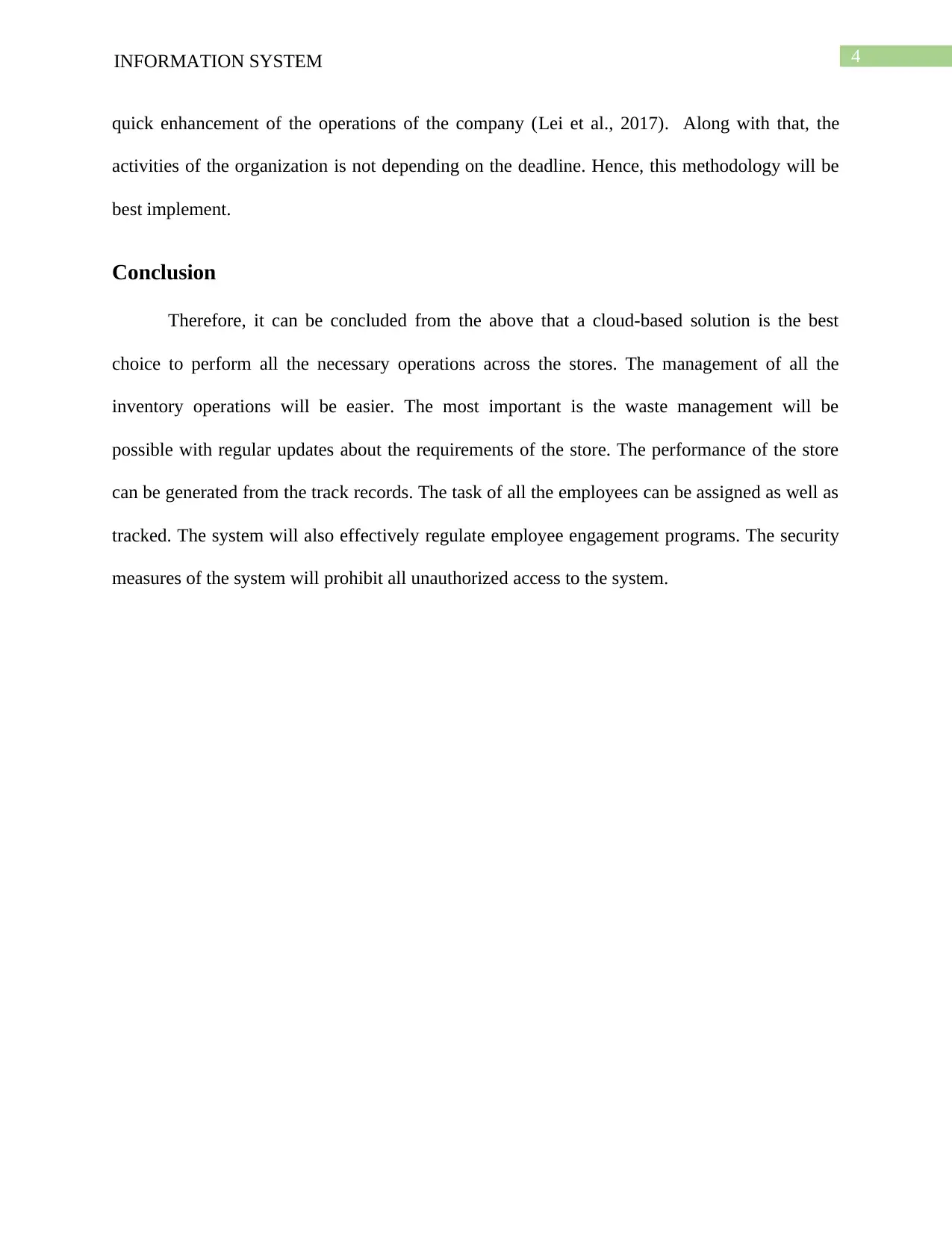
4INFORMATION SYSTEM
quick enhancement of the operations of the company (Lei et al., 2017). Along with that, the
activities of the organization is not depending on the deadline. Hence, this methodology will be
best implement.
Conclusion
Therefore, it can be concluded from the above that a cloud-based solution is the best
choice to perform all the necessary operations across the stores. The management of all the
inventory operations will be easier. The most important is the waste management will be
possible with regular updates about the requirements of the store. The performance of the store
can be generated from the track records. The task of all the employees can be assigned as well as
tracked. The system will also effectively regulate employee engagement programs. The security
measures of the system will prohibit all unauthorized access to the system.
quick enhancement of the operations of the company (Lei et al., 2017). Along with that, the
activities of the organization is not depending on the deadline. Hence, this methodology will be
best implement.
Conclusion
Therefore, it can be concluded from the above that a cloud-based solution is the best
choice to perform all the necessary operations across the stores. The management of all the
inventory operations will be easier. The most important is the waste management will be
possible with regular updates about the requirements of the store. The performance of the store
can be generated from the track records. The task of all the employees can be assigned as well as
tracked. The system will also effectively regulate employee engagement programs. The security
measures of the system will prohibit all unauthorized access to the system.
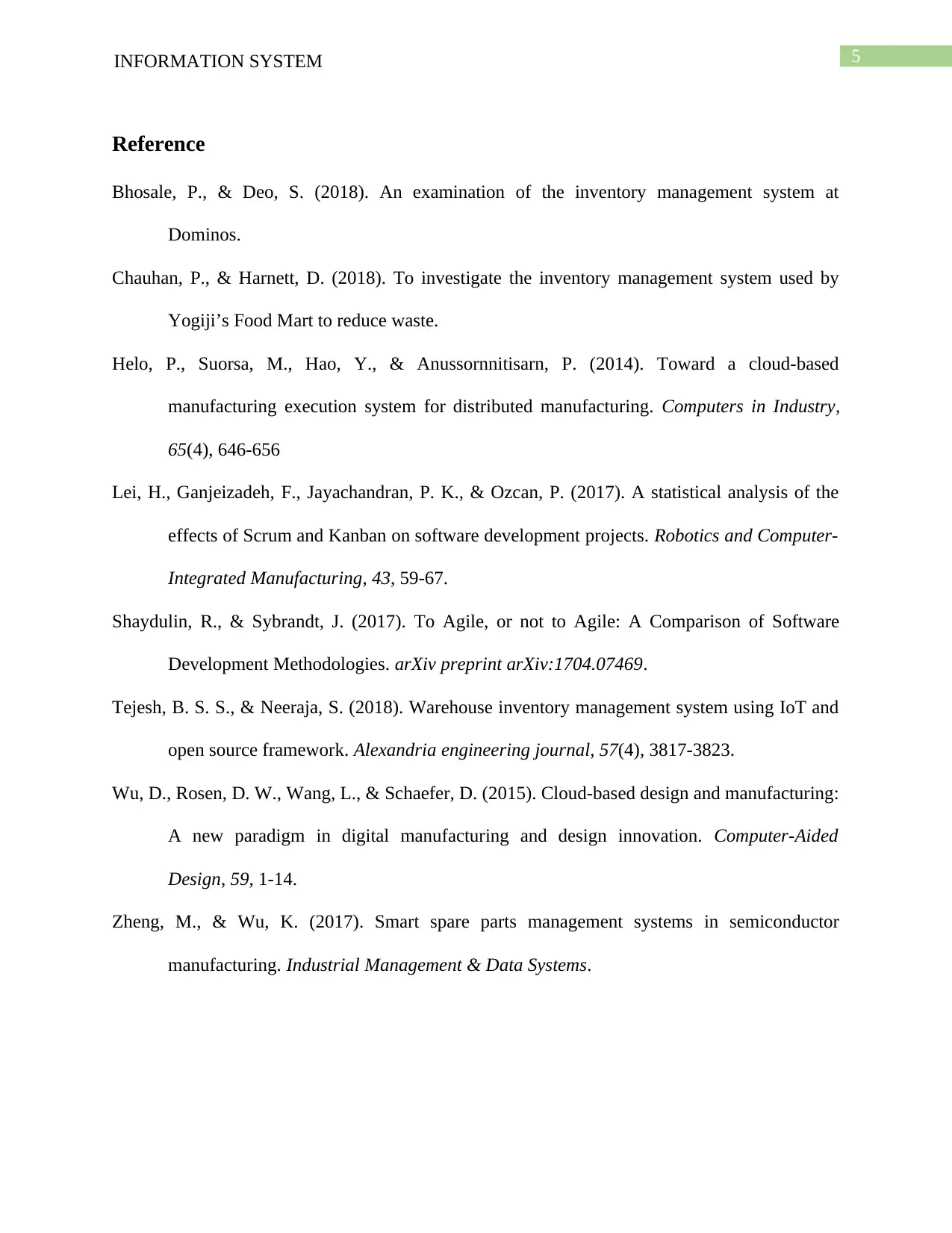
5INFORMATION SYSTEM
Reference
Bhosale, P., & Deo, S. (2018). An examination of the inventory management system at
Dominos.
Chauhan, P., & Harnett, D. (2018). To investigate the inventory management system used by
Yogiji’s Food Mart to reduce waste.
Helo, P., Suorsa, M., Hao, Y., & Anussornnitisarn, P. (2014). Toward a cloud-based
manufacturing execution system for distributed manufacturing. Computers in Industry,
65(4), 646-656
Lei, H., Ganjeizadeh, F., Jayachandran, P. K., & Ozcan, P. (2017). A statistical analysis of the
effects of Scrum and Kanban on software development projects. Robotics and Computer-
Integrated Manufacturing, 43, 59-67.
Shaydulin, R., & Sybrandt, J. (2017). To Agile, or not to Agile: A Comparison of Software
Development Methodologies. arXiv preprint arXiv:1704.07469.
Tejesh, B. S. S., & Neeraja, S. (2018). Warehouse inventory management system using IoT and
open source framework. Alexandria engineering journal, 57(4), 3817-3823.
Wu, D., Rosen, D. W., Wang, L., & Schaefer, D. (2015). Cloud-based design and manufacturing:
A new paradigm in digital manufacturing and design innovation. Computer-Aided
Design, 59, 1-14.
Zheng, M., & Wu, K. (2017). Smart spare parts management systems in semiconductor
manufacturing. Industrial Management & Data Systems.
Reference
Bhosale, P., & Deo, S. (2018). An examination of the inventory management system at
Dominos.
Chauhan, P., & Harnett, D. (2018). To investigate the inventory management system used by
Yogiji’s Food Mart to reduce waste.
Helo, P., Suorsa, M., Hao, Y., & Anussornnitisarn, P. (2014). Toward a cloud-based
manufacturing execution system for distributed manufacturing. Computers in Industry,
65(4), 646-656
Lei, H., Ganjeizadeh, F., Jayachandran, P. K., & Ozcan, P. (2017). A statistical analysis of the
effects of Scrum and Kanban on software development projects. Robotics and Computer-
Integrated Manufacturing, 43, 59-67.
Shaydulin, R., & Sybrandt, J. (2017). To Agile, or not to Agile: A Comparison of Software
Development Methodologies. arXiv preprint arXiv:1704.07469.
Tejesh, B. S. S., & Neeraja, S. (2018). Warehouse inventory management system using IoT and
open source framework. Alexandria engineering journal, 57(4), 3817-3823.
Wu, D., Rosen, D. W., Wang, L., & Schaefer, D. (2015). Cloud-based design and manufacturing:
A new paradigm in digital manufacturing and design innovation. Computer-Aided
Design, 59, 1-14.
Zheng, M., & Wu, K. (2017). Smart spare parts management systems in semiconductor
manufacturing. Industrial Management & Data Systems.
⊘ This is a preview!⊘
Do you want full access?
Subscribe today to unlock all pages.

Trusted by 1+ million students worldwide
1 out of 6
Related Documents
Your All-in-One AI-Powered Toolkit for Academic Success.
+13062052269
info@desklib.com
Available 24*7 on WhatsApp / Email
![[object Object]](/_next/static/media/star-bottom.7253800d.svg)
Unlock your academic potential
Copyright © 2020–2025 A2Z Services. All Rights Reserved. Developed and managed by ZUCOL.





